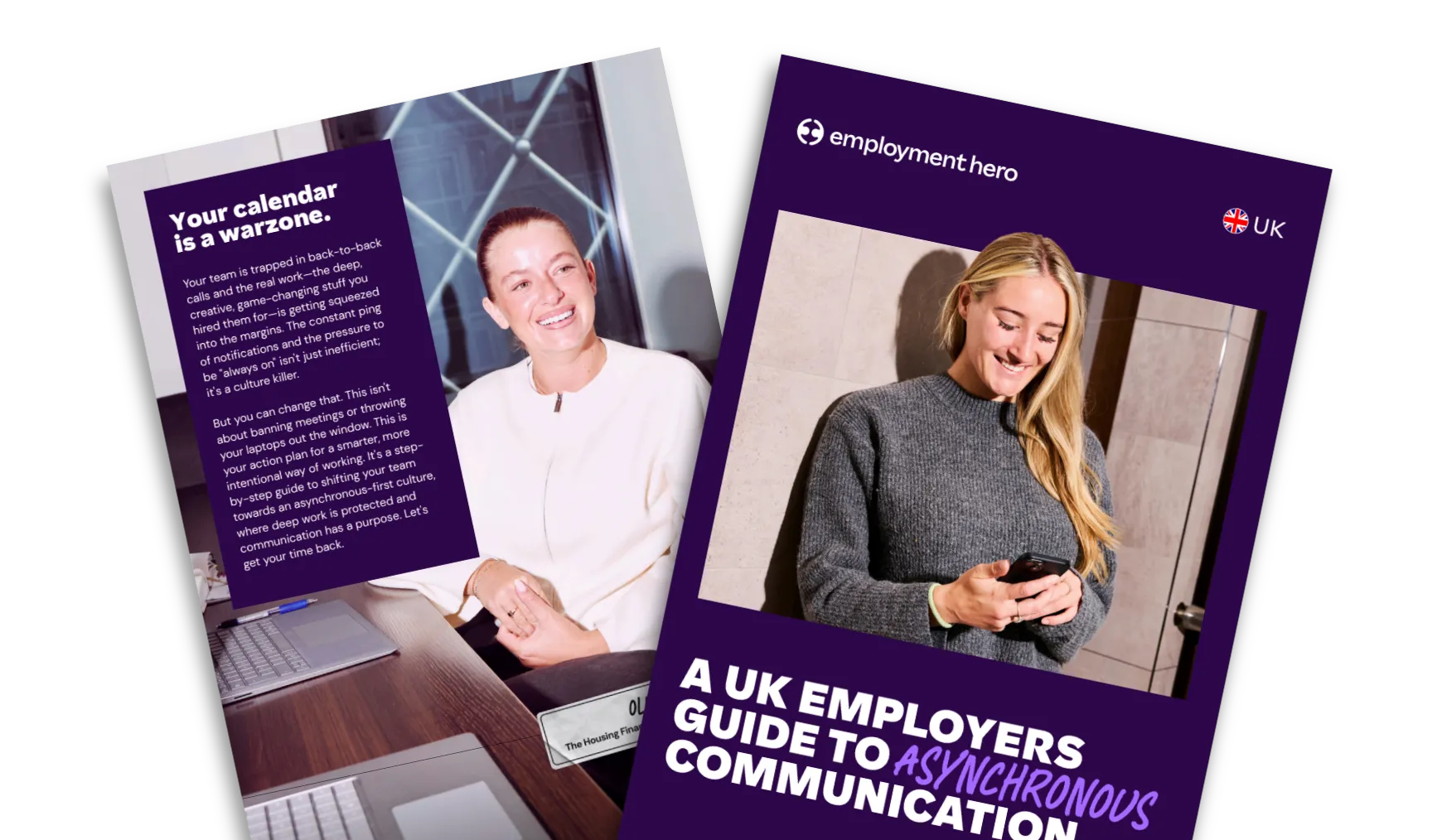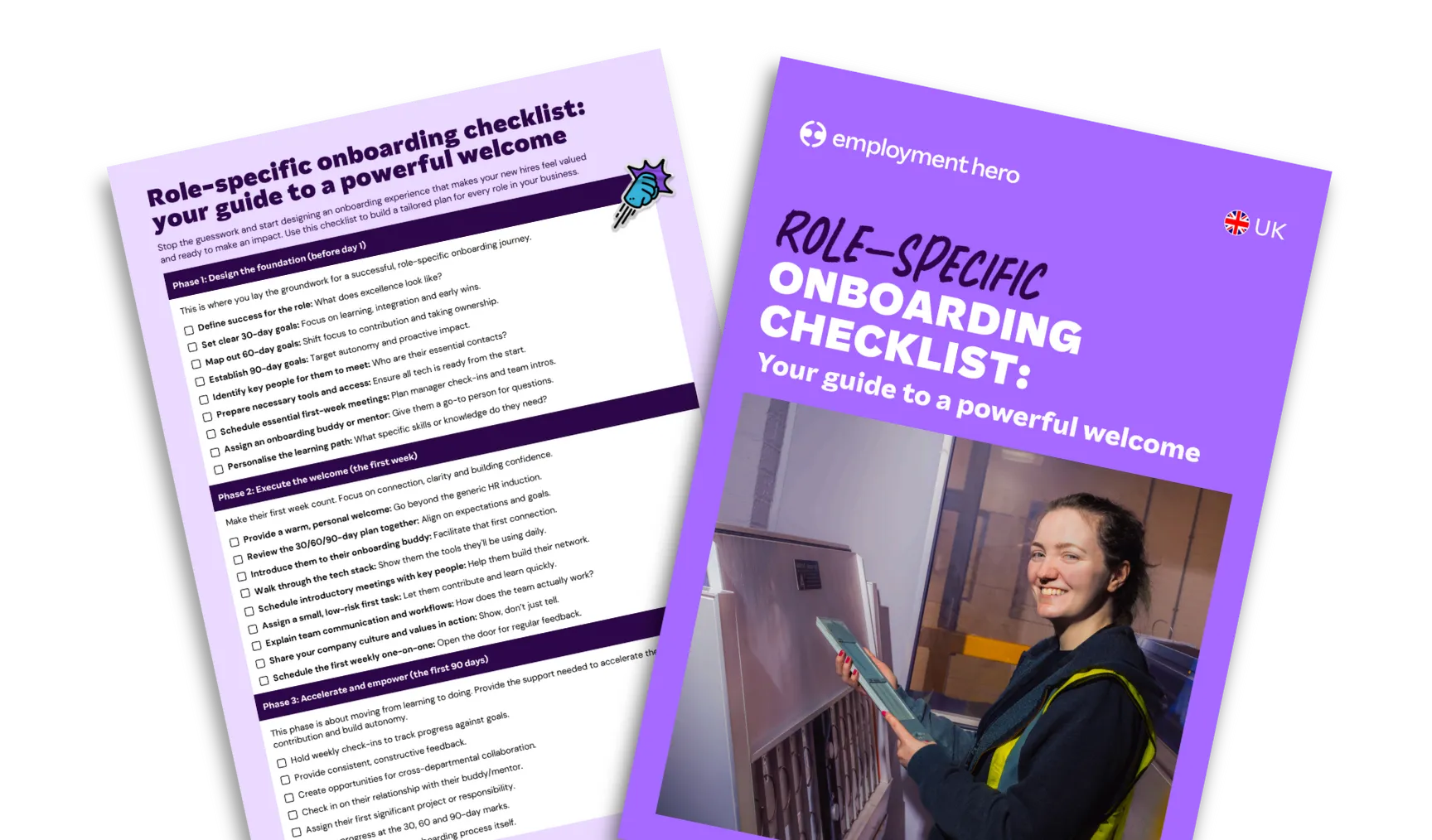The Ultimate End of Year HR Planning Guide
Published
The Ultimate End of Year HR Planning Guide
Published
End of year (EOY), whether it be calendar year or financial year is a busy time for HR professionals and small business owners. The panic of trying to understand any changes in employment law for the following year, getting important documentation filled out and considering recruitment needs is enough to have anyone tearing their hair out.
But despite the to-do list being as long as your arm, it doesn’t have to feel like an impossible task. This is where human resource planning (HRP) comes into play. But what exactly is HRP?
In The Ultimate End of Year HR Planning Guide, we cover:
- What is HRP
- The importance of end of year HR planning
- Challenges of human resource planning
- EOY human resources checklists
- Future trends
- Types of HR planning
- Steps of HR planning
- Goals & Important dates for 2026
What is HR planning?
Human resource planning (also called workforce planning or strategic human resource planning) is the proactive process of forecasting an organisation’s staffing needs and aligning them with business goals. Unlike reactive hiring, HR planning anticipates future workforce requirements, builds a pipeline of talent and ensures your human resource plan supports long-term strategy.
Simply put: HRP is about balancing current capabilities with future demands so your people power business success.
For most businesses, there are two times in the year in which HRP is a worthwhile activity:
- End of calendar year – this is the perfect time to reconsider policies and processes, take legal changes into account and start preparing strategy for the next twelve months.
- End of financial year – this is an integral time for payroll and tax compliance.
Why is HR planning important?
Human resource planning is more than just predicting staffing needs, it’s a strategic tool that connects people with business outcomes. Regardless of whether you’re a growth focused small business or a large organisation managing complex needs, HRP ensures your workforce (and company) is equipped, engaged and aligned with future goals.
1. Drives efficiency and cost savings
One of the biggest benefits of HR strategy planning is operational efficiency. By forecasting talent needs in advance, organisations avoid costly over-hiring or scrambling to fill critical gaps.
2. Reduces business risks
Reactive hiring often leads to rushed decisions and mis-hires. HR planning mitigates risks by preparing for workforce fluctuations, retirements or sudden resignations. It also helps businesses stay compliant with employment regulations, ensuring that workforce decisions are proactive and not reactive.
3. Supports organisational growth and agility
Strategic people processes are essential for scalability. As businesses expand into new markets or adopt new technologies, a robust human resource plan ensures the right mix of skills is available to meet evolving demands. Without it, growth can stall due to talent shortages.
4. Improves talent retention and engagement
Retention is one of today’s biggest operational challenges. HR planning allows employers to focus on employee development, succession planning and career pathways, factors that significantly improve engagement and loyalty.
5. Aligns HR strategy with business strategy
At its core, HRP is about alignment. It bridges human resources with broader business objectives, ensuring your people strategy fuels long-term success. For example, if your business plans to launch a new product in Q3, HR planning makes sure you have the right sales, marketing and technical support staff in place ahead of time.
6 Key steps in the end-of-year HR planning process
It’s important to remember that HR planning isn’t a one-off activity, it’s an ongoing cycle. The end of the year is a natural point to reflect, recalibrate and set your workforce strategy for the year ahead. Here’s how to build a strong human resource plan in six steps:
1. Review business goals
The best place to start is by looking at your company’s strategic objectives for the coming year. Consider:
- Are you planning to expand into new markets?
- Will technology or automating HR processes change how work gets done?
- Do you anticipate scaling teams or restructuring?
By grounding your HR planning in business strategy, you ensure people resources directly support growth. For example, if leadership is prioritising customer experience moving into 2026, your HR plan might focus on hiring more frontline staff and investing in customer service training.
2. Conduct workforce analysis
Workforce analysis is the strategic process of considering a business’ current workforce (including skills, demographics, performance and trends) to forecast future needs and identify gaps between current supply and projected demand.
In order to take stock of your current workforce capacity and capabilities, consider:
- Headcount by team and department.
- Employee demographics (age, tenure, diversity mix).
- Skills inventory and performance levels.
- Turnover trends and absenteeism rates.
A workforce analysis highlights where you’re strong and where gaps exist. This information becomes critical when working on human resource planning strategies.
3. Forecast future needs
Understanding where you are currently is an important start, but growth focused businesses need to be looking towards the future. This can be achieved through anticipating demand for roles and skills in the upcoming year. Consider:
- Projected business growth or decline
- Emerging technologies requiring new expertise
- Seasonal or cyclical workforce needs
- Internal mobility opportunities
4. Develop a human resource plan
Now, translate your insights into a structured action plan. This should include:
- Recruitment strategies – where will you find talent?
- Learning and development initiatives – what skills need strengthening?
- Retention programs – how will you keep high performers engaged?
- Succession planning – who is ready to lead if needed?
Think of this step as creating a “people roadmap” that supports business priorities while also enhancing employee experience.
5. Implement HR initiatives
Once you have a strategy in place, you need to think about how it can be implemented. Some tips for implementation include:
- Launch Q1 recruitment campaigns now, so hires are onboarded early in the year.
- Schedule leadership training in Q2 to prepare future managers.
- Introduce new performance management tools in line with company-wide strategy updates.
Implementation works best when HR partners closely with business leaders to ensure alignment and accountability.
6. Monitor and adjust regularly
HR planning is never “set and forget.” The most effective plans are monitored quarterly to track progress and adjust for real-world changes. Key questions to ask include:
- Are hiring timelines being met?
- Do employee engagement and retention metrics show improvement?
- Have business priorities shifted mid-year?
By building in flexibility, your human resource planning becomes a living document rather than a static plan, keeping your workforce strategy resilient and relevant.
End-of-year HR planning tips
The end of the year is the perfect opportunity to pause, reflect and set your people strategy up for success in the coming year. Beyond formal processes, here are some practical tips to make your end-of-year HR planning more effective:
1. Conduct a retrospective on the current year
Look back before you look forward. Review key HR metrics such as:
- Employee turnover rates and reasons for exit.
- Absenteeism and engagement scores.
- Recruitment performance (time-to-hire, cost-per-hire).
- Training and development outcomes.
This retrospective helps you identify patterns, such as skill shortages or retention issues, that can inform your next human resource planning cycle.
2. Use performance reviews to inform forecasts
Performance reviews aren’t just about feedback; they’re a goldmine for HR planning data. End-of-year reviews can highlight:
- High-potential employees ready for succession planning
- Skills gaps that require training or new hires
- Employees at risk of disengagement or exit
Integrating this data into your workforce planning ensures you’re proactive, not reactive, about both development and retention.
3. Align HR goals with next year’s strategic objectives
Your human resource and planning efforts should mirror business strategy. For example:
- If leadership plans to expand into new markets, HR may need to prioritise multilingual hires or region-specific expertise.
- If the business is focusing on digital transformation, L&D programs in data literacy or AI adoption may be critical.
When HR goals and business goals are aligned, talent becomes a true driver of growth.
4. Set Q1 priorities
Don’t wait until January to start. By setting Q1 priorities before the end of the year, you give your HR team and managers a head start. Consider:
- Finalising job descriptions and launching recruitment ads early
- Scheduling onboarding programs for January hires
- Setting dates for quarterly training or leadership workshops
Starting strong in Q1 sets the tone for the rest of the year and prevents “catch-up mode” later on.
5. Communicate the plan
A human resource plan is only effective if people know about it. Share your HR planning insights with managers and department heads, so they understand how workforce initiatives support broader strategy. Clear communication also reduces resistance to change and encourages buy-in across the organisation.
6. Leverage technology and data
Manual HR planning can be time-consuming, error-prone and reactive. By using an integrated platform like Employment Hero, HR leaders can transform how they approach end-of-year planning.
Employment Hero’s all-in-one HR software gives you real-time workforce analytics across payroll, performance, recruitment and employee engagement—helping you see the full picture of your team. Instead of juggling spreadsheets, you can:
- Simplify performance reviews with digital review workflows, feeding directly into your HR plan.
- Forecast talent needs using headcount and turnover data at your fingertips.
- Track workforce costs through integrated payroll insights.
- Identify skills gaps with performance and learning data, so you know where to invest in training or new hires.
- Use AI-driven insights and analytics to anticipate trends like employee attrition and future hiring needs.
By consolidating your human resource planning into Employment Hero, you make the process more accurate, predictive and aligned with business strategy, so you can focus less on admin and more on building the workforce of the future.
Common Challenges in HR Planning (and how to overcome them)
Even the best-designed people strategies can face obstacles. Recognising these challenges early and planning mitigation strategies is key to making HR planning effective. Here are the most common hurdles and how to overcome them:
1. Lack of data visibility
Without accurate workforce data, HR planning becomes guesswork. Many businesses still rely on outdated spreadsheets or fragmented systems, making it difficult to get a clear view of headcount, skills and turnover trends.
How to overcome it:
- Invest in a Human Resource Information System (HRIS) that integrates data across payroll, recruitment and performance management.
- Use analytics dashboards to track KPIs such as cost-per-hire, training ROI and attrition rates.
- Make workforce data accessible to business leaders to inform decision-making.
2. Resistance to change
Employees and managers may resist new HR planning initiatives, whether it’s adopting workforce planning software, restructuring teams or rolling out succession programs. This resistance often stems from uncertainty, fear of extra workload or lack of clarity.
How to overcome it:
- Communicate clearly how HR planning supports both the business and individual career growth.
- Involve managers early in the planning process to secure buy-in.
- Provide training and support to ease the adoption of new processes and technology.
3. Forecasting inaccuracies
Predicting future workforce needs is inherently challenging. External factors such as economic downturns, industry disruptions or sudden shifts in business strategy can make forecasts obsolete.
How to overcome it:
- Use scenario planning (e.g., best case, worst case and likely case) instead of a single projection.
- Update forecasts quarterly to stay aligned with changing business conditions.
- Incorporate AI-powered forecasting tools to improve accuracy over time.
4. Talent shortages and skills gaps
One of the biggest challenges in human resource planning is dealing with labour market shortages. Even with a strong plan, businesses may struggle to find candidates with the right skills, particularly in high-demand areas like tech, healthcare and digital transformation.
How to overcome it:
- Focus on internal mobility: upskill and reskill existing employees to fill future roles.
- Build relationships with universities, training providers and industry networks.
- Strengthen employer branding to position your company as an attractive workplace.
5. Aligning HR and business strategy
Sometimes HR planning fails because it is treated as an isolated HR exercise rather than a business-wide strategy. If HR goals don’t align with organisational priorities, the plan quickly becomes irrelevant.
How to overcome it:
- Involve executives and department leaders in every stage of HR planning.
- Tie HR initiatives directly to measurable business outcomes (e.g., sales growth, customer satisfaction).
- Review alignment quarterly to ensure the human resource plan evolves with business strategy.
Supercharge HR planning with Employment Hero
Human resource planning plays a pivotal role for businesses and is an essential part of overall business success. But the reality is, finding the time and resources to focus on these initiatives can be tricky for HR professionals and business leaders.
The good news is there are ways to not only do the work better but also faster — freeing up some time along the way. Enter Employment Hero’s Employment OS (operating system). The powerful platform takes the traditional isolated elements of employment and puts them all into one place. Find and hire top talent, onboard employees, manage complex payroll, remain compliant and more.
Frequently Asked Questions
HR planning (also called human resource planning or HRP) means making sure your business has the right number of people, with the right skills, in the right roles, at the right time. In simple terms, it’s about matching your workforce to your company’s future needs so you can grow without disruption.
The 5 steps of human resource planning are:
- Analyse your current workforce – Understand your headcount, skills, and gaps.
- Forecast future needs – Predict the talent and skills you’ll need in the future.
- Identify gaps – Compare current workforce capabilities to projected needs.
- Develop a human resource plan – Outline recruitment, training, and retention strategies.
- Monitor and adjust – Track progress and update the plan as business needs change.
HR planning is important for businesses because it ensures your workforce supports your business strategy. Without it, companies risk talent shortages, high turnover, or skills gaps that slow growth. A solid human resource plan helps you:
- Reduce costs by avoiding overstaffing or last-minute hiring.
- Improve retention by aligning employee development with business goals.
- Stay adaptable in times of change, such as expansion, restructuring, or economic shifts.
The difference between HR planning and strategic planning is that strategic planning sets your company’s big picture goals (e.g., entering a new market, launching a new product, achieving growth targets), whereas HR planning ensures you have the people, skills, and resources to deliver on those goals.
In other words, strategic planning decides “what” the business wants to achieve; HR planning determines “who” will get it done and “how” to resource it effectively.
Register for the Downloadable
Related Resources
-
 Read more: Asynchronous Communication: Best Practices and How to Avoid Decision Latency
Read more: Asynchronous Communication: Best Practices and How to Avoid Decision LatencyAsynchronous Communication: Best Practices and How to Avoid Decision Latency
Learn how to implement asynchronous communication effectively. Discover its benefits, challenges and best practices for remote and hybrid teams.
-
 Read more: Role Clarity and Job Expectations: The Manager’s Guide
Read more: Role Clarity and Job Expectations: The Manager’s GuideRole Clarity and Job Expectations: The Manager’s Guide
Learn how to define roles and responsibilities effectively. Discover actionable steps to improve role clarity and boost team performance.
-
 Read more: Role-specific onboarding: The complete guide and checklist
Read more: Role-specific onboarding: The complete guide and checklistRole-specific onboarding: The complete guide and checklist
Learn how to create a role-specific onboarding plan that engages and empowers new hires. Download the free checklist to personalise…



















